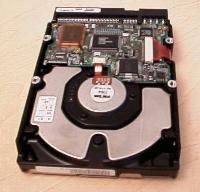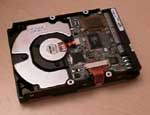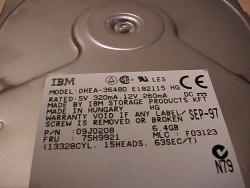IBM Deskstar 5 - 6.4 GB Hard Disk
by Anand Lal Shimpi on January 8, 1998 7:43 AM EST- Posted in
- Storage
 |
If this were a perfect and ideal world IBM would make the best computers, Microsoft would make the best Operating System, and Intel would make the best processors. Why? Because, for the most part, those three companies were the foundation for the hardware, software, and microprocessors we use in our computers today. Fortunately, the laws of any competitive market such as this one prevent that from happening mainly since all users have different needs and desires all of which can't be fulfilled by any single company. When it comes to hard drives and storage devices though, IBM does in fact hold a position of high stature due to the performance, quality, and reliability of their prominent yet virtually unknown line of storage products, particularly the IBM Deskstar 5. |
When you walk into your local computer parts retailer and waltz into the storage area you see stacks of red and white boxes lining the shelves like a neatly painted chess board. Maxtor and Western Digital hard drives surround you with gigabytes of storage capacity in an enclosure no larger than a small paperback book. In the far corner you may notice something of interest, a white box, however not a Western Digital drive. Instead it features the blue logo of a little company known as International Business Machines, or IBM. The mounds of drives are quite intimidating yet your curiosity and temptation keep you from purchasing anything other than the uniquely packaged IBM drive.
The previous account was one I faced while walking through a local retail store, shopping for a Hard Drive for a friend. To my amazement there was only one IBM Deskstar 5 - 6.4GB drive in stock, when I questioned a nearby salesman about why this was he responded by saying that "the IBM drivers are less desirable than the Maxtor and Western Digital drives since they aren't as fast" and then offered me a similarly priced Western Digital drive. The main point here is to acknowledge that although they might not be the most popular drives in the market the Deskstar 5 series is definitely an outstanding achievement on IBM's part.
As with most retail packaged hard drives, the IBM Deskstar 5 - 6.4GB comes with an EIDE Interface cable, OnTrack Disk Manager software (for older systems with a non-translating BIOS i.e. doesn't support drives over 540MB), a comprehensive user's manual, a pack of screws, and a set of 5.25" brackets for adapting the 3.5" drive to a 5.25" bay.
The cable included with the Deskstar 5 is a very high quality cable, not one of your generic run of the mill cables. The end which plugs into your motherboard (or EIDE Controller) features a sort of clip on attachment to prevent any accidental detachment of the cable from the board/card. However these two clips can provide a bit of difficulty with the installation and configuration of jumpers (etc...) that may reside in close proximity of the EIDE Connector.
| The user's manual IBM decided to package with the Deskstar 5 is probably one of the best manuals I have ever seen next to a hard drive, it not only documents the installation and operation of the hard drive in 20 different languages, but it also provides some explanations as to how to partition your new drive, etc... I could find only two flaws with the Deskstar 5 user's manual, and they were just that the manual doesn't use any helpful illustrations to aid first time upgraders with installing the product, and the second flaw being that in one particular place IBM decided to exploit one of my few pet peeves, they referred to hard disk storage space as memory. For those of you that do refer to Hard Disk space as memory, you shouldn't confuse it with RAM, you can call it memory, however it is always better to refer to it at storage space, disk space, or something along those lines. It is a huge annoyance to have someone talk about having 3GB of memory and 64MB of Hard Disk when they mean the exact opposite. |  |
IBM managed to make their documentation even better (hard to imagine) by including a User's Guide Supplement which lists jumper settings, Hard Disk Drive Technical Specifications, and an accurate and thorough description of the IBM Warranty policy.
The drive itself boasts 5400 RPM spin rate (compared to the 5200 RPM spin rate of most Western Digital drives) and a roomy 512KB buffer, [up to] 40KB of which is reserved for use with firmware. A 9.5 ms average Read Seek Time and a 10.5 ms average Write Seek Time are two of the fastest seek times you will see in the industry for this type of hard drive, one could go as far as to say that the IBM Deskstar 5 truly offers SCSI Performance at an EIDE price. As listed in the specifications of the drive, the Deskstar 5 series from IBM are some of IBM's very first EIDE drives to make use of the Ultra ATA-33 (otherwise known as UltraDMA/33, DMA/33, UDMA, or whatever you may have heard it called) extension to the AT-Attachment (ATA) specification. Theoretically the maximum burst transfer rate of any Ultra ATA-33 drive is a whopping 33.3MB/s, however as we all know, actually achieving that high of a transfer rate is about as easy as running Windows 95 with 4MB of RAM ;)
The actual sustained data transfer rate on the 6.4GB Deskstar 5 was quoted by IBM as being in the range of 5.7MB/s - 10.2MB/s, which is not bad at all...if you believe IBM. Actually, IBM's statement is quite accurate, in the tests that were run on the Deskstar 5 the average transfer rate fell between 7.6MB/s and 9.3MB/s, with the average random access time (not seek time) being approximately 12.9 ms, decent for a drive of this class.
 |
Now one of the major advantages of going with an Ultra ATA-33 drive is that it offers SCSI-like performance for a cost much less than a genuine SCSI (Small Computer System Interface) hard drive and you don't have to worry about purchasing an additional controller card since EIDE controllers are normally built onto motherboards, you don't even need a TX or LX based motherboard to use the Deskstar 5 (technically you need one to take advantage of the Ultra ATA-33 transfer rates, however if you really want ATA-33 support on your current motherboard try Promise Technology's Ultra33 Controller Card). While the performance of the 6.4GB Deskstar 5 tested here could be compared to that of some SCSI drives, one advantage SCSI drives still hold over EIDE models is that of the low CPU Utilization of SCSI drives, due to the lack of any processor overhead (SCSI Controllers handle all requests to the SCSI Bus). The CPU Utilization of the Deskstar 5 was about 30.8% in the tests that were run, this number is about average for drives in its class however it is much lower than a handful of the "generic" EIDE drives you'll see pop up around the retail market. |
Quality and the Deskstar 5 are two terms that can pretty much be used interchangeably, the quiet spin of the Deskstar 5 and the low heat production of the drive make it ideal for do or die situations that aren't ready for the move to a hot and noisy SCSI Drive. Don't expect your Deskstar 5 to die out anytime soon, however manufacturing defects are inevitable, if they happen, they happen, it is good to know that IBM stands behind their products with an excellent 3 year limited liability warranty policy.
How I Tested
Each benchmark was run 3 times, an average was taken from all three test runs and used as the final score.
No foreign drivers were present in the test system other than those required for the system to function to the best of its ability
All foreign installation files were moved to a separate partition during the test as to prevent them from effecting the test results
The hard drive was split into 2.1GB FAT-16 partitions, the number of partitions depended on the physical size of the hard drive. All modifications to the partition size of the hard drive were made using F-Disk packaged with Microsoft Windows 95 Service Release 2.
A collection of files was transferred totaling 79.4MB, 81,305.6KB, or 8,325,6934.4 Bytes (a megabyte in this case is equal to 210 kilobytes or 1024KB), to simulate multitasking tests a parallel port Zip drive copying sequence was initiated and run in the background while the files were being copied.
Test Configuration
| Processor(s): | Intel Pentium II - 300 (512K ECC) |
| Motherboard: | AOpen AX6L |
| RAM: | 1 x 64MB Corsair Microsystems SDRAM DIMMs |
| Hard Drive(s): | IBM Deskstar 5 -
6.4GB Ultra ATA-33 Western Digital Caviar - 6.4GB Ultra ATA-33 |
| Video Card: | Matrox Millennium II (4MB WRAM - AGP) |
| Busmaster EIDE Drivers: | Intel 3.01 |
| Video Card Drivers: | MGA Millennium 4.03.00.3410 |
| OS: | Windows 95 Service Release 2 |
Disk Winmarks - Winbench 98 |
|||
| Business Disk Playback Tests | |||
| Score | Units | ||
| IBM Deskstar 5 | Western Digital 6.4GB UDMA | ||
| Overall: | 1360 | 1220 | Thousand Bytes/Sec |
| Spreadsheet/Database: | 1240 | 1080 | Thousand Bytes/Sec |
| Word Processing: | 1620 | 1490 | Thousand Bytes/Sec |
| Publishing: | 1280 | 1150 | Thousand Bytes/Sec |
| Browsers: | 1380 | 1310 | Thousand Bytes/Sec |
| Task Switching: | 1780 | 1710 | Thousand Bytes/Sec |
| High End Disk Playback Tests | |||
| Score | Units | ||
| IBM Deskstar 5 | Western Digital 6.4GB UDMA | ||
| Overall: | 4010 | 3580 | Thousand Bytes/Sec |
| AVS/Express: | 2280 | 2120 | Thousand Bytes/Sec |
| Frontpage 97: | 3270 | 2970 | Thousand Bytes/Sec |
| Microstation 95: | 7980 | 7090 | Thousand Bytes/Sec |
| Photoshop 4.0: | 3660 | 2910 | Thousand Bytes/Sec |
| Premiere 4.2: | 7400 | 6490 | Thousand Bytes/Sec |
| PV-Wave 6.1: | 2810 | 2680 | Thousand Bytes/Sec |
| Visual C++ 5.0: | 8970 | 7390 | Thousand Bytes/Sec |
| Disk/Read Random Access: | 12.9 | 12.8 | Milliseconds (lower is better) |
| Disk Read Transfer Rate | |||
| Score | Units | ||
| IBM Deskstar 5 | Western Digital 6.4GB UDMA | ||
| Beginning: | 9280 | 10300 | Thousand Bytes/Sec |
| End: | 7630 | 9750 | Thousand Bytes/Sec |
| Disk/Read CPU Utilization: | 30.8 | 34.3 | Percent Used (lower is better) |
Windows 95 Performance |
||
| IBM Deskstar 5 | Western Digital 6.4GB UDMA | |
| Windows 95 Installation Time (copying files): | 3 min 2.66 sec | Not Run |
| Windows 95 Boot Time: | 13.79 sec | Not Run |
| File Transfer w/ Zip Drive Copying: | 8 min 12.89 sec | Not Run |
| File Transfer (no multitasking): | 28.51 sec | 31.39 sec |
The IBM Deskstar 5 - 6.4GB drive is, hands down, one of the best EIDE/Ultra ATA-33 drives out in the market today and for the price. The performance, and quality of the hard drive is unmatched by most of its competitors so the final decision in this case is quite simple.










0 Comments
View All Comments